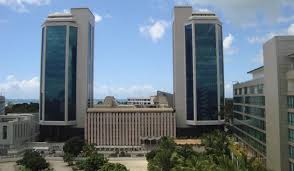Are there plans to reduce the commercial banks minimum reserve ratio as a measure to increase the banks operating funds to spur lending to the productive sectors? Are there plans to reduce the discount rate any time soon? The central bank is quiet on these questions….
By Jaston Binala
Bank of Tanzania data confirms the Tanzania population is cash-strapped, which analysis can prove is reason for subdued spending in the economy. The cash crunch is forcing inflation down, but there are sectors hurting from the subdued consumer spending.
I am told a bank branch recently closed operations in the usually bustling Kariakoo area of Dar es Salaam. Business is down. A tourist hotel called JB Belmont in the northern Tanzanian city of Mwanza was forced to close business on account of defaulting from its rent payment obligations. It was not making money. Mark that as chapter one in Tanzania’s prudent monetary policy.
Chapter two deals with banks and hotels again and this time it is not one hotel but three. A Kiswahili tabloid reported in mid July another JB Belmont hotel has closed its door at Benjamin Mkapa Towers in Dar es Salaam. Customers do not frequent the hotel in sufficient numbers to justify its continued existence. Another hotel called Golden Jubillee was reported closed for the same reasons.
TZ Business News broke the story on troubles in the hotel industry when the website reported on troubles at the Ubungo Dar es Salaam Landmark Hotel. The customer base deteriorated so much at this hotel revenue could not sustain the workforce. Many workers had to be retrenched as a result. Owners have now transformed the hotel into a university hostel. There may be other sectors hurt by Tanzania’s strict monetary policy but whose details may be known in the days to come.
Of course one or two people in Tanzania may still be able to buy land, houses as others continue with wedding plans under the existing conditions; life will always contain exception because it provides different strokes for different folks. But the facts and figures at hand indicate need may exist to relax the tight monetary stance.
Banks in Tanzania offer what they call competitive lending rates. This is done to create room for preferential rates to attract customers. However, in January 2016, the overall average lending rate in banks had jumped from 15.69% a year earlier to 16.28%.
 The interest rate spread between 12-month deposit and lending rates widened, to 3.33 percentage points in January 2016, up from 3.06 percentage points in the preceding month. This was a nudge toward making it difficult for businesses to get cash for operations in 2016.
The interest rate spread between 12-month deposit and lending rates widened, to 3.33 percentage points in January 2016, up from 3.06 percentage points in the preceding month. This was a nudge toward making it difficult for businesses to get cash for operations in 2016.
On a different note, in January this year transactions in the inter-bank cash market were reported by the Bank of Tanzania to have amounted to Tsh 1,166.7 billion, compared with Tsh. 709.6 billion in the preceding month. Overnight transactions accounted for 79.4 percent of the total transactions, which was lower than the share of 99.7 percent recorded in the preceding month.
The overall inter-bank cash market rate rose to 12.02 percent from 7.29 percent in December 2015, while the overnight rate increased to 11.9 percent from 7.1 percent. Money was slightly more costly to access in January.
The bank of Tanzania has not responded to questions from this website on various monetary policy issues including questions concerning the discount rate and the minimum reserve ratio, which both impact on the money supply. The silence provides room for speculation.
I believe the discount rate at the Bank of Tanzania is higher now than was the case in 2009. It may currently be around 12%– up from 3.7% in 2009. It is therefore too costly to borrow from the lender of last resort, which may be a good reason for commercial banks to keep away from frequent borrowing from the central bank. Again, Money is too costly to get and therefore banks must be stingy. Call that chapter three on Tanzania’s prudent monetary policy.
In April last year, the Bank of Tanzania increased the minimum commercial banks reserve ratio from 8% to 10%. This was calculated to reduce liquidity in the market, and this ratio has not changed up to this moment as far as I know. Once again, money is being removed from easy access.
Now enter the new Tanzania Government. A heated election was held in 2015 in which the ruling party narrowly escaped defeat. The new Government, under leadership of the beloved Dr. John Pombe Magufuli, has set out to prove itself valid–maybe to serve the people of the United Republic of Tanzania, maybe to make it a little easier in the 2020 election. One place to prove the validity has been the area of finances. President Magufuli wants a stingy government. A stingy Government does not spend much and crumbs don’t fall. That, too, may contribute to a tight monetary policy. Make that chapter four.
On June 8, 2016, Tanzania’s Minister of Finance presented the 2016/17 budget. The Minister, Dr. Philip Mpango, said the Government revenue estimates for 2016/17 would be Tsh. 29.53 trillion of which Tsh.18.46 trillion would be internally sourced through taxes and non-tax revenue, representing 62.3% of the GDP. This meant 37.7% would be sourced from somewhere else.
The new government has information Tanzania is debt-ridden, and the question of donor dependency is politically explosive.They want to keep a safe distance from external sources as much as it is possible. In 2015 the International Monetary Fund (IMF) issued a debt sustainability analysis report which said “Tanzania’s Public and Publicly Guaranteed (PPG) external debt as a share of GDP has steadily increased in recent years”.
The IMF report said Tanzania’s “primary fiscal deficit has been a major contributor to public debt accumulation”. In June, Dr Mpango told the National Assembly in Dodoma that the national debt stock stood at US$ 20.94 billion as of March 2016 compared to US$ 19.69 billion in June 2015, representing an increase of 6.34 per cent.
“Out of this amount, public debt was US$ 17.93 billion and private external debt was US$ 3.01 billion,” he said, adding that “the public debt increased by 6.01 per cent compared to US$ 16.92 billion in June 2015.”
Concequently, the new Government is afraid of foreign sources of budget funds. Deliberate effort has thus been made to borrow from the local money market as much as possible. A good idea indeed–but one that has impacted the money supply. The Bank of Tanzania has instructions to borrow from the general public on behalf of the Government in order to close part of that 37.7 % deficit.
BoT has made Treasury Bill and Bonds so attractive records indicate people have shifted focus away from equities at the Dar es Salaam Stock Exchange in favour of Government papers. The equities market was reported starving—especially somewhere between March and June, 2016. While the bills and bonds BoT campaign may have been done in good faith to help the Government bridge its budget deficit, the instruments have also helped “mop-up” excess liquidity—adding salt to injury one would say, considering the high interest rates in commercial banks and the puffed up minimum reserve ratio.
Are there plans to reduce the minimum reserve ratio as a measure to return money back into commercial banks to spur lending to the productive sectors? Are there plans to reduce the discount rate any time soon? The central bank is quiet on this also.
How long will this tight monetary stance remain in force? The central bank is silent about this question too. A loose monetary policy can result in the sprouting of small businesses, even as inflation is increased in a calculated risk according to some schools of thought. BoT has not responded to this question either.




